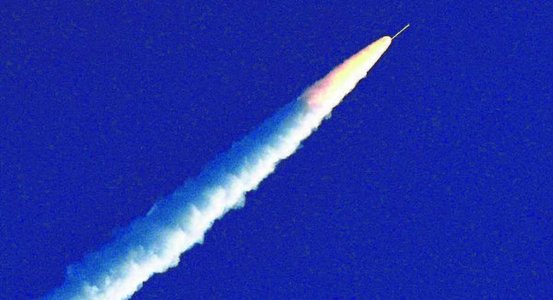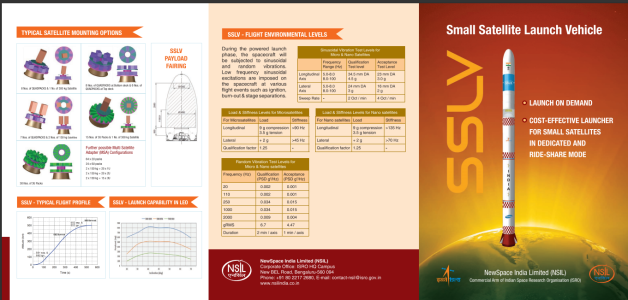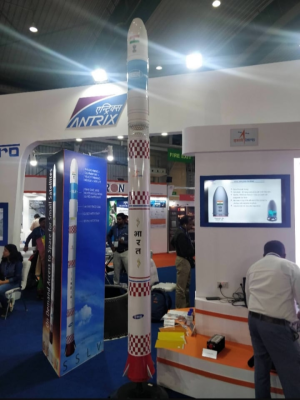You are using an out of date browser. It may not display this or other websites correctly.
You should upgrade or use an alternative browser.
You should upgrade or use an alternative browser.
Small Satellite Launch Vehicle (SSLV) - News, updates and reports
- Thread starter haldilal
- Start date
More options
Who Replied?- Joined
- Jun 30, 2024
- Messages
- 161
- Likes
- 907
ISRO will launch first dedicated SSLV commercial mission in 2026

ISRO’s commercial arm NSIL said on June 26 that its newest rocket, the Small Satellite Launch Vehicle (SSLV), will have its first dedicated commercial launch when it puts into orbit the Optimus -- a satellite built by Australia-based Space Machines Company.
Full report: https://www.thehindu.com/sci-tech/s...ommercial-mission-in-2026/article68351875.ece

ISRO’s commercial arm NSIL said on June 26 that its newest rocket, the Small Satellite Launch Vehicle (SSLV), will have its first dedicated commercial launch when it puts into orbit the Optimus -- a satellite built by Australia-based Space Machines Company.
Full report: https://www.thehindu.com/sci-tech/s...ommercial-mission-in-2026/article68351875.ece
- Joined
- Jun 27, 2024
- Messages
- 1,766
- Likes
- 5,279
SSLV Technical Brochure from 2019:
https://www.nsilindia.co.in/sites/default/files/u1/SSLV Technical Brochure V12.pdf


https://www.nsilindia.co.in/sites/default/files/u1/SSLV Technical Brochure V12.pdf


- Joined
- Jun 27, 2024
- Messages
- 1,766
- Likes
- 5,279
A brief overview:

Quick look:
SSLV or Small Satellite Launch Vehicle is a small lift launch vehicle for commercial and emergency launches.
Air launched and ship/submarine launched variants may emerge there in near future if demanded by navy and air force.
On a usual medium to heavy, expendable launch system, it takes from two weeks to 3 months to fabricate parts and assemble launch system on pad. In case of SSLV, we can do it in 2 days to 4 days within minimal manpower and can facilitate us 40-60 orbital launches per year.
The very purpose of creating a separate thread for SSLV is same.
SSLV or Small Satellite Launch Vehicle is a small lift launch vehicle for commercial and emergency launches.
Air launched and ship/submarine launched variants may emerge there in near future if demanded by navy and air force.
On a usual medium to heavy, expendable launch system, it takes from two weeks to 3 months to fabricate parts and assemble launch system on pad. In case of SSLV, we can do it in 2 days to 4 days within minimal manpower and can facilitate us 40-60 orbital launches per year.
The very purpose of creating a separate thread for SSLV is same.
- Will be used to launch microsatellites that will not be notable enough to have separate thread.
- Too many launches in a single year in future, we don't have to make a thread to cover every single launch. Sometimes, we may not even cover launch and just post statistics.
- To evaluate performance of Indian launch industry. As SSLV is a short cycle rocket and it's one launch can't be compared to that PSLV/GSLV/LVM3.
All further design & details of this system will be covered here but may be moved to make another dedicated thread for design if large range of variants emerge.
Strategic:
Besides India, there are only three countries (US, Russia and PRC) with active ASAT capabilities. Ability to shoot down enemy satellite doesn't work very well if enemy can do same to you. As putting a missile shield in space on satellite can't justify it's cost, it's better to possess ability to launch more satellites quickly into orbit.
US has Minotaur series of small rockets, Russia has Start-1 launch system, and China possess Kuiazhou 1 and 1A. India so will have SSLV and its variants.
Launch:
Will have a dedicated launch site called SSLC different from two existing launch pads (FLP and SLP) located in SDSC. Till new site is ready, FLP will be integrated with vehicle to facilitate at least demonstration launches to start operation and bag commercial orders.
Credit: @Indx TechStyle
Strategic:
Besides India, there are only three countries (US, Russia and PRC) with active ASAT capabilities. Ability to shoot down enemy satellite doesn't work very well if enemy can do same to you. As putting a missile shield in space on satellite can't justify it's cost, it's better to possess ability to launch more satellites quickly into orbit.
US has Minotaur series of small rockets, Russia has Start-1 launch system, and China possess Kuiazhou 1 and 1A. India so will have SSLV and its variants.
Launch:
Will have a dedicated launch site called SSLC different from two existing launch pads (FLP and SLP) located in SDSC. Till new site is ready, FLP will be integrated with vehicle to facilitate at least demonstration launches to start operation and bag commercial orders.
Credit: @Indx TechStyle
- Joined
- Jun 27, 2024
- Messages
- 1,766
- Likes
- 5,279
- Joined
- Jun 27, 2024
- Messages
- 1,766
- Likes
- 5,279
- Joined
- Jun 27, 2024
- Messages
- 1,766
- Likes
- 5,279
Back in 2020:
Spaceflight gets first crack at India’s new SSLV rocket – and puts up a ‘sold out’ sign
https://www.geekwire.com/2019/ampere-scientific/
OP: @Suryavanshi
Spaceflight gets first crack at India’s new SSLV rocket – and puts up a ‘sold out’ sign
https://www.geekwire.com/2019/ampere-scientific/
OP: @Suryavanshi
Last edited:
- Joined
- Jun 27, 2024
- Messages
- 1,766
- Likes
- 5,279
Tender for FLP integration.
https://www.isro.gov.in/sites/default/files/tenders/pt-16_04.pdf
OP: @Indx TechStyle
https://www.isro.gov.in/sites/default/files/tenders/pt-16_04.pdf
OP: @Indx TechStyle
- Joined
- Jun 27, 2024
- Messages
- 1,766
- Likes
- 5,279
- Joined
- Jun 27, 2024
- Messages
- 1,766
- Likes
- 5,279
A Technical Failure was found while testing of the small satellite carrier motor:
Video on failure by Gareeb Scientist:
View: https://youtu.be/KOthvOLDnek
Sriharikota, News Today: A technical glitch occurred during the motor test of a small satellite carrier (SSLV) conducted on Thursday at the Satish Dhawan Space Center in Sharjah, the Indian Space Launch Center. Preparations are underway to launch the first small satellite carrier from Sharjah in April. As part of this, a constant test was performed on the SS1 solid fuel motor in the SSLV carrier and a fault occurred in the nozzle section. Scientists are conducting reviews to find out the error. ISRO will conduct a static test again after identifying and correcting the error.
Video on failure by Gareeb Scientist:
View: https://youtu.be/KOthvOLDnek
- Joined
- Jun 27, 2024
- Messages
- 1,766
- Likes
- 5,279
More on the Failure by @Indx TechStyle
Failure confirmed in MSM. It was nozzle design issue. Finding issue with design, making new nozzle and testing/validating will take an year now. Not 6 months as he highlighted because fault diagnose will take time
The static test of first stage solid motor (SS1) of ISRO's Small Satellite Launch Vehicle (SSLV) -- a new-generation compact rocket -- was not successful, according to sources in ISRO. "Oscillation was noticed after 60 seconds into the test and nozzle was blown out near the bucket flange where it's attached with the motor at around 95 seconds", sources in the Bengaluru-headquartered space agency said.
It was supposed to be tested for a total duration of about 110 seconds, officials said.
The Indian Space Research Organisation had targeted to launch the first development flight of SSLV (D1) in April and may now in all probability have to revise this schedule.
"SSLV First stage is a new solid motor...new design.
New motor has to be static tested on the ground to prove its performance. If it is successful, one more of the same configuration is tested again for acceptance.
If both are successful, no more ground test is required and third motor of the same configuration will be accepted for flight", an ISRO official said.
SS2 and SS3 motors, igniters and SS2 flex nozzle assembly, liquid propulsion-based VTM (Velocity Trimming Module) thrusters, propellant tanks and propulsion components had already been realised by ISRO and made ready for the maiden orbital test flight.
"We have to identify the root cause of the failure and modify the design", the official said on the unsuccessful testing at Sriharikota spaceport in Nellore district of Andhra Pradesh, about 100 kms north of Chennai, last week.
Asked how long it may take for ISRO to complete the two static tests, the official said: "Maybe six months".
SSLV is two metres in diameter and 34 meters in length with a lift-off weight of about 120 tons.
ISRO has over the years realised five generations of launch vehicles -- SLV-3, ASLV, PSLV, GSLV and GSLV-MkIII.
The space agency had earlier said the SSLV is going to be a new member of the launch vehicle family.
It is intended to cater to emerging global small satellite launch service market.
"We are flying an earth observation satellite (EOS-02) on board the the first development flight of SSLV", ISRO Chairman and Secretary in the Department of Space, K Sivan said last month.
SSLV has been designed to meet "launch on demand" requirements in a cost-effective manner for small satellites in a dedicated and ride share mode.
It is a three-stage all solid vehicle with a capability to launch up to 500 kg satellite mass into 500 km low earth orbit (LEO) and 300 kg to Sun Synchronous Orbit (SSO).
By comparison, PSLV -- the workhorse of ISRO -- can take up to 1,750 kg payload into SSO of 600 km altitude.
With lower per kg launch cost, the mini launcher will have multiple satellite mounting options for nano, micro and small satellites.
Sivan had earlier termed the SSLV an innovative vehicle, which can be assembled in just 72 hours.
"Instead of 60 days (for building a PSLV), it (SSLV) will be assembled in three days; instead of 600 people (needed to build a PSLV), it (SSLV) will be done by six people", he had said.
Chairman and Managing Director of ISRO's commercial arm, NewSpace India Limited (NSIL), G Narayanan, recently said: "the world over there is a big boom for small launch vehicles and that's why we are focusing on that".
The US-based satellite ride share and mission management provider, Spaceflight Inc., has already purchased the first commercial launch of the SSLV (SSLV-D2) from NSIL for launch from the Satish Dhawan Space Centre in Sriharikota.
Spaceflight had said at the time that it has already sold out the entire manifest (launch) for this secured SSLV-D2 launch, with spacecraft from an undisclosed U.S.-based satellite constellation customer.
This undisclosed customer is reportedly Seattle-based BlackSky Global, which will launch four earth observation satellites on board SSLV-D2 in the ride share mission arranged Spaceflight.
"Were taking advantage of the growth in the small satellite market to deliver more launch options with the mini-launcher", a senior NSIL official said.
"The SSLV is the much-needed solution to fill the gap in the portfolio of small launch vehicles," Curt Blake, CEO and President of Spaceflight, had said.
"SSLV is designed for the launch-on-demand concept with very quick turn-around capability in between launches.
SSLV is perfectly suited for launching multiple micro satellites at a time and supports multiple orbital drop-offs", Blake had said.
- Joined
- Jun 27, 2024
- Messages
- 1,766
- Likes
- 5,279
- Joined
- Jun 27, 2024
- Messages
- 1,766
- Likes
- 5,279
Updates from July 2022:
SSLV First Mission
OP: @Indx TechStyle
SSLV First Mission
The space agency is also awaiting clearance for the launch of the first Small Satellite Launch Vehicle (SSLV), a technology demonstrator mission of which is expected in the coming weeks. While Isro is confident of an August launch, the final date, an official said, “was yet to be decided”. “We are looking at August, but it may not happen in the first few days.”
Isro has done extensive testing of the SSLV, with the key ground testing of the newly developed solid booster stage (SS1) also having been completed. This test was considered the last major test before the tech-demonstrator mission.
The SSLV will have more than one technology demonstrator mission before it can be used as a mainstream launcher. Once that is achieved, Space PSU NewSpace India Limited (NSIL) is also looking at utilising the rocket for commercial missions.
OP: @Indx TechStyle
- Joined
- Jun 27, 2024
- Messages
- 1,766
- Likes
- 5,279
The launch of the SSLV-D1/EOS-02 Mission is scheduled for Sunday, August 7, 2022, at 9:18 am (IST) from Satish Dhawan Space Centre (SDSC), Sriharikota:
View: https://x.com/isro/status/1554003107545092096
OP: Vamsi
View: https://x.com/isro/status/1554003107545092096
OP: Vamsi
- Joined
- Jun 27, 2024
- Messages
- 1,766
- Likes
- 5,279
- Joined
- Jun 27, 2024
- Messages
- 1,766
- Likes
- 5,279
- Joined
- Jun 27, 2024
- Messages
- 1,766
- Likes
- 5,279
- Joined
- Jun 27, 2024
- Messages
- 1,766
- Likes
- 5,279
- Joined
- Jun 27, 2024
- Messages
- 1,766
- Likes
- 5,279
Latest Replies
-
Indian Special Forces
- VictorDelta4
-
2024 US Presidential Elections
- crazywithmath
-
India Canada Relations
- ezsasa
-
Indian Navy Developments & Discussions
- Corvus Splendens
-
Russian Ukrainian War
- shade2
-
Israel - Hamas Conflict
- shade2
-
DRDO and PSU's
- superpower
-
Jokes Thread
- COLDHEARTED AVIATOR
-
Indian Small Arms and Weapons
- ArjunMK1A
-
CI/CT Operations
- notaname
Trending Threads
Donate via Bitcoin - bc1qpc3h2l430vlfflc8w02t7qlkvltagt2y4k9dc2



